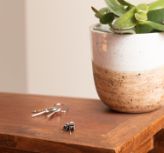Typically one of the largest hearing aid styles, a BTE hearing aid offers the most power of hearing aid styles. Some miniature versions are available.
- These hearing aids fit on top and around the outer ear and connect to a custom earpiece within the ear.
- Excellent for almost all types of hearing loss.
Is it right for me? A durable, versatile style, BTEs use advanced technology to perform exceptionally well everywhere, including noisy listening environments. As a result, they are great for even the most active lifestyles.
These are among the best hearing aids for seniors.












